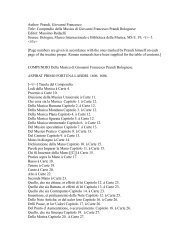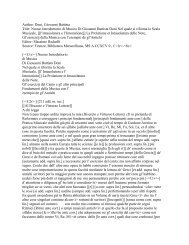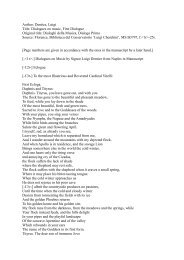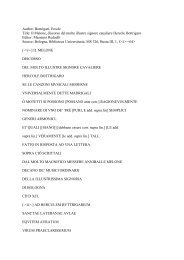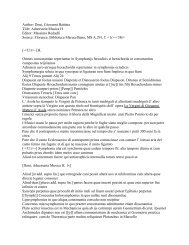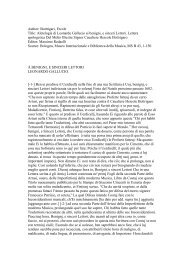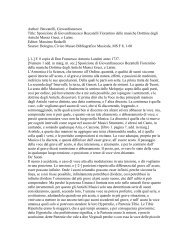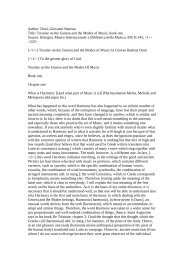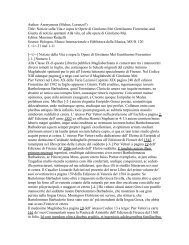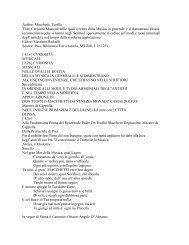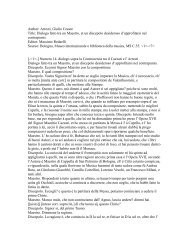Manuscripts of Italian Music Theory in Translation
Manuscripts of Italian Music Theory in Translation
Manuscripts of Italian Music Theory in Translation
Create successful ePaper yourself
Turn your PDF publications into a flip-book with our unique Google optimized e-Paper software.
the Diapente or the Diapason by press<strong>in</strong>g on the frets, and not be<strong>in</strong>g any more the basisand the foundation, it produces a good sonority, but not otherwise.Even relatively to the third po<strong>in</strong>t, namely that <strong>in</strong> Venice the Greeks s<strong>in</strong>g it <strong>in</strong> theirPsalmodies, one should not be surprised at this, because they try to support this op<strong>in</strong>ionwhich derives from Greek Authors, who th<strong>in</strong>k that the Diatessaron is perfect.As to the fact that one f<strong>in</strong>ds that Iosqu<strong>in</strong>o used it only once <strong>in</strong> a Motet <strong>of</strong> his for twovoices, this could also be a pr<strong>in</strong>t<strong>in</strong>g mistake, which happens so <strong>of</strong>ten <strong>in</strong> pr<strong>in</strong>ted words. Itis not logical that, if he used it once and it produced a good effect, he should not haveused it many more times <strong>in</strong> his compositions, but this is not the case. [signum]However, do let us go back to the qualities which are conta<strong>in</strong>ed between those numbers,and we shall f<strong>in</strong>d, as I have already said, that they derive from each other, and it isimpossible that the dissonances should not jo<strong>in</strong> their pr<strong>in</strong>ciples or attach themselves toany other support which would susta<strong>in</strong> them to produce a pleasant comb<strong>in</strong>ation <strong>of</strong> sounds.And if the Composer, for <strong>in</strong>stance, does not jo<strong>in</strong> the second [-f.22v-] with the third or toanother consonance and the seventh, called heptachord, to the major or m<strong>in</strong>or hexachord,or to another one which assimilates it and creates a pleasant union <strong>of</strong> sounds, nobody willbe able to stand such a harshness <strong>of</strong> sound. I said that one f<strong>in</strong>ds that they derive from eachother. I mean by this that the second is born from the unison, the third from the secondand the fourth from the third. Thus, they depend one on the other <strong>in</strong> succession, as I saidabove, so that if one puts the Diatessaron as basis and foundation <strong>of</strong> the Composition byitself, as <strong>in</strong> this example[Landi, Introduttione harmonica, 22v, 1]one never hears that gives the ear anyth<strong>in</strong>g but discomfort. On the contrary, if theDiatessaron is laid out <strong>in</strong> this way[Landi, Introduttione harmonica, 22v, 2]it produces a wonderful comb<strong>in</strong>ation <strong>of</strong> sounds. This happens because the Diatessaron iscreated by the Diapente and by the Diapason, and therefore it will never be perfect. Thus,I do not understand this op<strong>in</strong>ion <strong>of</strong> his, s<strong>in</strong>ce one can see that by itself it cannot conta<strong>in</strong>perfection without its orig<strong>in</strong> which is the Ditone, or semiditone. I do not deny that it isdifferent from the second and the seventh, s<strong>in</strong>ce one can clearly see that the number twois different from the three, and the number four is aga<strong>in</strong> different, albeit they all derivefrom the same orig<strong>in</strong>. This is the orig<strong>in</strong> <strong>of</strong> variety and Harmony.Zarl<strong>in</strong>o says (at Chapter 7 <strong>of</strong> the third part) that the Diapason is more perfect that theDiapente, and the Diapente more so than the Diatessaron. I reply that it is true that theDiapason is more perfect than the Diapente, but the Diatessaron has no perfection that canbe compared to this, because <strong>of</strong> the above mentioned reasons. Instead, s<strong>in</strong>ce it isrepresented by the middle number, [-f.23r-] it should participate <strong>of</strong> the character <strong>of</strong> theimperfect consonance to which it is jo<strong>in</strong>ed. However, when it is by itself, it is dissonant,



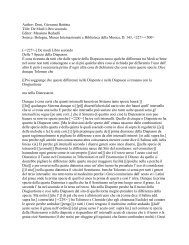
![Doni, Giovanni Battista Title: Trattato Dei Tuoni o [[Harmonie de]]](https://img.yumpu.com/45461005/1/190x245/doni-giovanni-battista-title-trattato-dei-tuoni-o-harmonie-de.jpg?quality=85)
